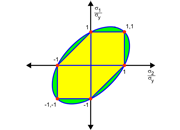Instrumented Pressure Vessel Stress Analysis
The IPV shown below was subjected to an external pressure of 1000 psi (6.9 mPa), and FEA analyzed using SolidWorks Simulation. 1000 psi is equal to a seawater depth of 2250ft (686m). The FEA Analysis shows that the average stress in the pressure tube is about 10700 psi (73.8 mPa), and the average stress at the center of the end cap is about 11400 psi (78.6 mPa). The highest stress of 24957 psi (172 mPa) is the result of a singularity at the corner between the IPV ID and the O-ring ID surface. The pressure rating is limited by the O-Rings, which are rated at 1500 psi (10.3 mPa).
Pressure Vessel FEA. External Pressure = 1000 PSI (6.9 mPa)

Pressure Vessel Stress Calculations using Classical Stress Analysis. MapleSoft Was Used to Solve the Roark's Stress Analysis Equations.
External Pressure = 1000 psi (6.9 mPa)
Using MapleSoft and Roark's Formulas for Stress and Strain to calculate IPV stress is quicker than creating a SolidWorks model of the IPV and subjecting it to a FEA analysis. This method is useful when quick estimate of IPV stress is needed without the rigor of an FEA analysis. The stress values shown below at 1000 psi are in agreement with the FEA analysis results.





Connect With Us